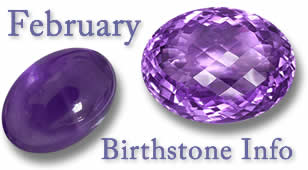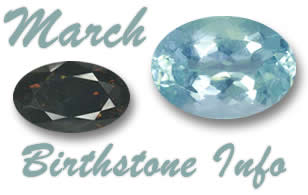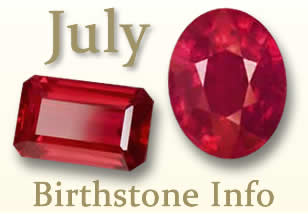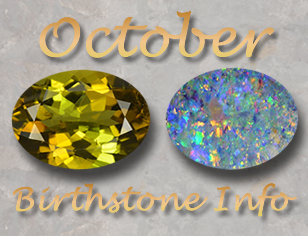What can I find in this article?
- What is the color of the January birthstone?
- The Etymology, History and Lore of the January Birthstone
- What is the spiritual meaning of garnet?
- Healing Properties and Health Benefits of Garnet
- Durability of Garnet
- Cleaning and Caring for January Birthstones
- Is it safe to wear garnet jewelry every day?
- How much do garnets cost?
- Are there any secondary January birthstone?
- Final Thoughts on the January Birthstone
Garnet - The January Birthstone

Garnet is the birthstone of people born in January. This gemstone occurs in a wonderful spectrum of vibrant colors. Whether it is the fiery orangish Mandarin garnet, or the rich greenish tsavorite variant, this January birthstone is one of the most exquisite gemstones you will encounter. One of the most common variants of garnet is pyrope garnet, which is also deemed to be an excellent gift, symbolizing friendship, loyalty, and trust.
The history of garnets spans back several thousands of years, during which time it has protected those travelling far and wide. According to folklore and legend, garnets have the power to light up the nights. This January birthstone was even meant to protect its owner from dark and spine-chilling nightmares.
Thanks to its durability and versatility, garnet is used extensively in modern jewelry design of all types.
In addition to its use as a January birthstone, garnet is given as a gift for various occasions. On the second wedding anniversary, for example, it is customary to give red garnet.
For most people, garnet evokes thoughts of red, and this has been the case for millennia; but those searching for a January birthstone today have a much broader field of color from which to choose. Garnet offers hues of green, orange, pinkish orange, deeply saturated purplish reds, and even some blues. Red garnet is indeed one of the most commonly occurring gemstones, most often tinged with brown, yellow, and violet. Tsavorite garnet, a green variety, is far rarer due to the unique metamorphic conditions in which it is formed - extensive folding and refolding of rock.
Although all garnets have the same crystal structure, they tend to differ with respect to chemical composition. A family of more than twenty varieties of garnet is broken down into categories called species. Only five of these species are of gemstone quality; they are almandine and pyrope (the red garnets), spessartine (the orange to red-brown species), grossular (greens, browns, reds, and yellows), and andradite (red, yellow, brown, green or black). There is a sixth garnet, uvarovite that is also used in jewelry; however, it is found in sizes that are typically too small to cut (druzy or crystal cluster), so this green garnet is used in its natural occuring as druzy-crystal clusters.
The January birthstone can also exhibit an effect called "color-change": a phenomenon that causes the color of the gemstone to shift depending on the type and temperature of the light in which it is viewed. Blue pyrope-spessartine color-changes from blue-green to purple; this is the rarest species of garnet. Incidentally, of the twenty plus species of garnet, many are a chemical mixture of two or more garnet species.
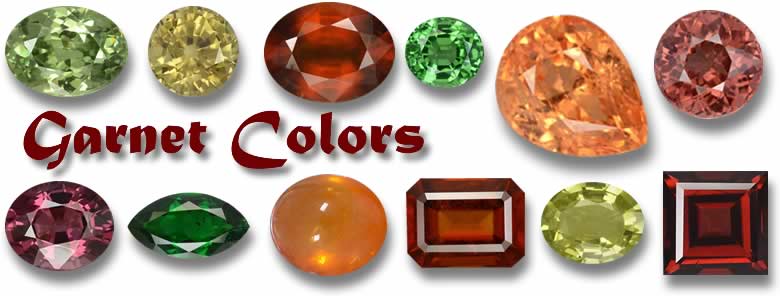
Referred to as carbuncle (a general term for red gemstones) in ancient times, the January birthstone was eventually given its name from the Middle English gernet (dark red), and the Old French grenate (pomegranate red). It is widely accepted that this word can be traced back to the Latin granatum, used to describe a seeded fruit; in this case, the pomum granatum, or pomegranate, a fruit with vivid red seed covers. It would have been reasonable for ancient naturalists to observe the resemblance of red, granular garnets and liken them to pomegranate seeds.
Garnets have a rich history spanning back more than 5,000 years. The January birthstone was believed to be extensively used in Ancient Bohemia (now Czech Republic) during the Bronze Age (3000 - 1200 B.C.). In Egypt, too, garnet necklaces were worn by pharaohs in life, then taken to the afterlife as prized possessions. The gemstone was introduced in Sumer around 2100 B.C and in Sweden between 2000 and 1000 B.C.
In the Late Antique Roman era, red garnets were among the most highly traded gemstones; they were especially used to inlay gold cells, a technique called garnet cloisonn'.
During the Middle Ages (5th to 15th centuries AD), people from European countries used garnets for enhancing their faith, consistency, and truth. It was also used for dispelling sadness and depression. Known as a "warrior's stone" during the Great Crusades (1095-1291), garnet was a common talisman used by both Christians and Muslims.
According to Hebrew mythology, Noah's ark was lit by a large, finely cut, glowing red garnet. In the Christian tradition, the blood-red color of the garnet symbolizes the sacrifice of Christ. Alternatively, the Koran speaks of this gemstone illuminating Jannah, the fourth and final heaven of Muslims. In Jewish belief, garnet is believed to be one of the twelve precious stones featured on the iconic breastplate of Aaron, the high priest of the Israelites and brother to Moses.
The ancient Greeks recorded that garnets could prevent children from drowning and act as a powerful antidote to poison. Garnet was also used by various Native American Indians and African tribes, as well as the Mayans and the Aztecs as ornaments and decorations.
Red-hued garnets were extensively believed to offer complete invulnerability from life-threatening wounds, while inflicting them at the same time - certain Asiatic clans launched these gems from their bows.
Eventually, the January birthstone came to be used as bullets by the rebellious Hanza tribe in late 1892, as they waged a war against the British across the frontiers of Kashmir. The idea was that this blood-colored stone would result in deeper wounds than a lead bullet. Out of curiosity, a large number of these precious bullets were collected by British troops and can be viewed in museums today.
According to lore, a garnet would warn its owner of imminent danger; hence, it was used as a talisman for centuries. Historians tell us that if your garnet suddenly lost its sheen and luster, it was a direct indication of an impending disaster.
Garnet has been exchanged between couples to celebrate marriage anniversaries. Traditionally, it was given on the 19th anniversary; however, in modern times, garnet is considered the 2nd wedding anniversary gemstone.
Currently, garnet is not merely worn as an alluring ornament, it also has industrial uses. Whether it is to create watch gears, scientific tools, sandpaper or other abrasives, these January birthstones can do it all.
The January birthstone is found all over the world, but most of the world's supply of garnet comes from Africa, particularly Kenya, Tanzania, Namibia and Madagascar. Once mined in abundance from the Little Three Mine in San Diego California, spessartine garnet now comes primarily from Namibia and Tanzania.
Garnet is known for helping us utilize our creative prowess. Intimately tied to the Earth, the January birthstone keeps us grounded and working happily, despite our ups and downs. Garnet is also thought of as a sensual stone. It denotes the primordial fire, the inception of our universe from chaos, its eventual purification, and love. It is a gemstone that expresses powerfully intense emotions.
As the origin of the name garnet is connected to the word pomegranate, the January birthstone symbolizes the swift reunion of separated lovers, as in the Greek myth that tells of Hades and his gift of a pomegranate to Persephone, ensuring her speedy return. Thus, you can always give a garnet to your loved one before they head off for a trip. Moreover, this gemstone is believed to heal the bond between estranged lovers.
Garnet is deemed to be an extremely significant gemstone for restoring your health, boosting your creativity, rejuvenating your love life, and protecting you from many kinds of ailments. According to legends, a garnet inscribed with the image of a lion is believed to produce an effective and consistent charm that'll protect your health, cure you of illness, bless you with honors and achievements, and keep you safe from all impending perils as you travel far and wide.
From ancient times to the medieval period and today, the traits associated with various colors played a major role in determining a gemstone's medicinal value. Since the most common variants of garnet in ancient times were red, they were linked to blood and the heart. It was believed that garnets could regulate and stimulate the flow of the cardiovascular system, prevent and treat hemorrhage, and cure a host of inflammatory ailments.
The January birthstone also encourages the production of hemoglobin in our bodies. Moreover, the right variant of garnet stimulates our overall metabolism, prevents cellular ailments, re-energizes your blood and boosts DNA production. It further assists in assimilating vitamins and minerals.
Garnet is said to have healing properties for both men and women. Many women, for instance, wear garnet jewelry to foster hormonal balance and reduce swelling. Men, on the other hand, wear this garnet jewelry to cure heart palpitations, lung ailments and various conditions of the circulatory system - erectile dysfunction, for example.
The benefits of garnet aren't just limited to your physical health, they also extend to the realm of mental health and psychic healing. One of the biggest benefits of using this gemstone is that it induces passion, loyalty, self-confidence, trust, friendship, devotion, positive energy, and truth. As you start wearing this stone, you will start having clearer perceptions about yourself and the people around you.
In recent history, garnets were claimed to help the owner resist sadness. It was also believed to wade away negative, evil spirits, especially the ones that haunted at nights. Today, many individuals use this stone to ward off haunting memories and nightmares.
Since garnet also inspires you to contemplate and speak the truth, as you start wearing it, you will protect and maintain your integrity and overall reputation.
Garnet is also believed to be useful in business matters. As this stone draws people closer to its owner, garnet will naturally support better business relationships and their success. If you are not in business, but work in a people-oriented profession, you can also benefit from the amicable and approachable qualities imparted by garnet.
This January birthstone is perfect for people who are looking to step in to new realms and experiences. So, if you are relocating to a new city, wearing garnet can help you adjust to the unfamiliar environment.
Upon wearing garnet or using it as a healing gemstone, any form of challenge can be transformed into an opportunity.
Perhaps one of the biggest advantages of this stone is its inherent ability to assist people overcoming mental health conditions, such as depression. This gem has been known for reducing inherent behavioral patterns that are not only negative, but also highly detrimental to the individual and their family, friends and other relations. As people struggling with mental health begin using garnet, they will end up letting go of negative, destructive thought patterns and ideas.
The January birthstone will revitalize and purify your soul, perfectly balance your energy levels, and bring in the right amount of serenity. It will also help you evade inhibitions, superstitions, and discord. What's more, people experiencing emotional disharmony have experienced a calming effect upon wearing garnets. How? Because this stone will prevent you from being affected by the negative energy of the people around you.
Garnets are also said to boost your survival instincts during crises and moments of trauma. It makes way for hope in situations that seem impossible to resolve. Either way, it will prevent depression and allow your inherent spirit to radiate.
The January birthstone is an especially thoughtful gift for people who are struggling with the loss of a partner, or are grieving for a loved one. Garnet will soothe your emotional turmoil, impart a feeling of solace, and revitalize your soul.
Finally, this gemstone also has a deep-seated significance in terms of love and passion. Wearing garnet will allow you to explore your passionate side, stimulate your sex drive, and boost fertility.
The January birthstones diverse color range make it indispensable in cleansing and balancing the chakras.

Almandine garnet is red and, therefore, associated with the root chakra, making it a stone of physical love and relationships.
Andradite, occurring in red, yellow and green, is associated with the base, solar plexus and heart chakras, making it a stone of higher thinking, self-empowerment, strength and safety.
Grossular garnet is associated with the base, sacral, solar plexus, and heart chakras, due to its sunrise colors - yellow, gold, orange, and red - as well as the very popular green shade. This variety encourages gratitude and service to others.
Pyrope garnet is the most powerful of garnets; its color range from red to violet enables it to align the root and crown chakras, bringing complete balance to the individual.
Spessartite's gold, orange and red hues connect it to the sacral and solar plexus chakras, where it stimulates analytical thought, alleviates fears and provides confidence.
Finally, uvarovite, the only strictly green garnet, is tied to the heart chakra where it enhances spiritual relationships and imparts an acceptance of and love for the universe.
What is gemstone durability?
The concept of durability is comprised of three factors: hardness (resistance to scratching), toughness (resistance to chipping, cracking and breakage), and stability (resistance to chemical or environmental shock).
What is the hardness of garnet?
On the Mohs hardness scale (an index from 1, the softest, to 10, the hardest), garnet ranges from 6.5 to 7.5, due to the diversity of species. To put this into perspective, quartz, the second most abundant mineral on Earth, is at 7 on the Mohs scale. This is an important point because the inescapable presence of quartz means that it is airborne, can settle on jewelry, and be thoughtlessly wiped away, causing scratches to any material lower than Mohs 7.
As a result, special care must be taken when wearing, cleaning and storing the softest species of garnet - andradite and uvarovite (both 6.5 - 7) - to avoid scratches from gemstones and materials higher on the hardness scale, such as topaz (Mohs 8), ruby (Mohs 9) or diamond (Mohs 10). These species of garnet are more appropriate in earrings and necklaces, or fancy cocktail jewelry; though they can be worn every day in rings and bracelets with the appropriate amount of caution.
Harder species of garnet can be worn every day in all types of jewelry with less worry. Almadine and pyrope have the narrowest hardness range (Mohs 7 - 7.5), and would be ideal for everyday use in jewelry that is likely to encounter mechanical shock (bumps and knocks). Although spessartine and grossular have the broadest range of hardness (Mohs 6.5 - 7), they are still considerably hard and will resist scratches in everday use, if worn with some caution.
What is the toughness of garnet?
All gemstones are considered brittle to some degree, because they will eventually break, or cleave, when struck with enough force. For example, jade is the toughest gemstone and can be worn every day for years without a crack appearing, while topaz is considered to have poor toughness.
Toughness in gemstones is rated as exceptional (the highest), excellent, good, fair or poor (the lowest). Garnet has a toughness that is considered fair to good, making it durable enough for all types of jewelry.
What is the stability of garnet?
The January birthstone is highly stable; it is unaffected by light and common chemicals, though it can be attacked by hydrofluoric acid, a chemical found in rust removers. Despite the high degree of resistance to common chemicals, it is always safe to avoid exposure to any caustic chemicals, like cleaning products, when wearing jewelry of any kind.
As with any crystal structure - garnet included - high temperatures and thermal shock (rapid changes in temperature) can cause fractures and should, therefore, be avoided, although these conditions are less worrisome for garnet. However, it is still recommended that you not use steam cleaners with the January birthstone.
How can you clean garnet?
Warm, soapy water and a soft brush are the safest way to clean all gemstones, and garnet is no exception. Ultrasonic cleaners may be used with garnet, though they are generally not recommended by professionals because the vibrations can loosen settings and cause your garnets to become lost. While it is typically rare to treat garnet with fracture filling, ultrasonic cleaners are especially not to be used to clean garnet, or any gemstone, that has had this treatment.
After cleaning your garnet with a mild detergent, rinse it with clean water and dry it with a soft cloth. Air drying a gemstone will leave unsightly spots and disrupt the garnet's sparkle.
How can you store garnet?
Garnet species are very durable, but they can incur damage if not stored properly. Each piece of garnet should be kept separate from other gemstones and pieces of jewelry in a dedicated compartment of a fabric-lined jewelry box, placed in a cool and dry location. Individual cloth jewelry bags are also suitable if you have limited space in your box.
Another space-saving method is to use acid-free paper envelopes, called "parcel paper envelopes" or "diamond papers", to keep gemstones of the same hardness together and arranged in a parcel paper organizer box. Glass jars with foam or fabric inserts are perfect for those who want to showcase their loose gemstones and jewelry.
Absolutely! Garnet's durability make it an ideal gemstone for everyday use, especially for earrings, pendants and brooches - items less likely to suffer a knock against a hard surface. However, garnet is used extensively in rings and bracelets; rings are typically given protective settings and bracelets may be reserved more for special occasions.
Garnet Price List |
||
|
Color |
Weight range |
Price range / USD |
|---|---|---|
|
Almandine Garnet |
1ct |
$5 - $20/ct |
|
Almandine Garnet |
2ct |
$20 - $60/ct |
|
Color-Change Garnet |
1ct |
$45 - $200/ct |
|
Color-Change Garnet |
2ct |
$90 - $500/ct |
|
Demantoid Garnet |
1ct |
$60 - $800/ct |
|
Demantoid Garnet |
2ct |
$80 - $2000/ct |
|
Grossularite Garnet |
1ct |
$45 - $80/ct |
|
Grossularite Garnet |
2ct |
$80 - $300/ct |
|
Hessonite Garnet |
1ct |
$10 - $50/ct |
|
Hessonite Garnet |
2ct |
$20 - $100/ct |
|
Mali Garnet |
1ct |
$40 - $200/ct |
|
Mali Garnet |
2ct |
$50 - $300/ct |
|
Pyrope Garnet |
1ct |
$4 - $20/ct |
|
Pyrope Garnet |
2ct |
$8 - $50/ct |
|
Rhodolite Garnet |
1ct |
$15 - $70/ct |
|
Rhodolite Garnet |
2ct |
$20 - $200/ct |
|
Spessartite Garnet |
1ct |
$25 - $150/ct |
|
Spessartite Garnet |
2ct |
$50 - $400/ct |
|
Star Garnet |
Any Weight |
$3 - $50/ct |
|
Tsavorite Garnet |
1ct |
$100 - $1000/ct |
|
Tsavorite Garnet |
2ct |
$200 - $3000/ct |
As with all transparent gemstones, color, cut, clarity and carat will determine the price. We have talked a bit about color, but here is a note on clarity:
Clarity is another characteristic that is taken into consideration when evaluating garnet. These January birthstones are rated on a scale from internally flawless (IF), meaning that it has no inclusions, to heavily included (I3). To get some perspective, slightly included (SI) gemstones, in the middle of the scale, have inclusions that can be seen under 10x magnification, though not often with the naked eye.
The best thing to do when looking at loose gemstones is to first determine how you would like to use them. Garnet can be faceted, or left as a cabochon, and used in any jewelry setting.
Garnet pendants are popular with jewelry designers and can include any shape of gemstone. Why not give your partner a 1.3 carat, heart facet, green tsavorite garnet? It's ideal for a pendant and costs just over $900.
Earrings make a nice gift of January birthstone jewelry. A pair of 0.5 carat, oval facet VS demantoid garnet (a brilliant green variety of andradite), can be purchased for under $150. Or, if you are looking for the characteristic pomegranate-red stone, a pair of 2.8 carat, square cut, deep red pyrope garnet can be yours for just under $50.
If you are designing a necklace or bracelet, lots of garnet can be purchased for very reasonable prices. Consider a four piece set of 2 carat, marquise facet, deep red pyrope garnet, sized 12 x 6 mm each, for just $75. Or if you prefer the green tsavorite, you can find a 20 piece lot of 0.12 carat, diamond cut, sized 3mm each, for $200.
An iconic January birthstone ring is always appreciated. For just over $100 you can buy a 2.5 carat, cushion cut, fire red hessonite garnet (a variety of grossular garnet). What a statement such a ring would make at a fancy cocktail party!
With so many color varieties from the 6 gem-quality species of garnet, every wish for January birthstone jewelry can come true. Moreover, garnet is considered the sole January birthstone across the spectrum of calendars, from modern to traditional, Ayurvedic, Roman and Russian. All list garnet for January.
If you are interested in astrology and would like to wear birthstones that coincide with the two zodiac signs for January - Capricorn and Aquarius - then you can consider ruby, agate, and onyx (Capricorn birthstones); as well as amethyst, moss agate, opal, and sugilite (Aquarius birthstones).

Garnet is a versatile January birthstone with a wonderfully fascinating history of cultural importance and healing properties. Able to cleanse your blood and stimulate your circulatory system, garnet also has a strong connection to emotional matters of the heart and mind.
The January birthstone's durability and vast color palette provide an abundance of options when thinking about birthstone jewelry. If you are ready to start your search for that special garnet piece, visit a reputable gem dealer like Gemselect today!
Disclaimer
Disclaimer GemSelect has been buying and selling gemstones for many years now and in that time we have built up quite a relationship with our customers and suppliers. We are not experts in the meanings and health benefits of gemstones but we have been able to speak with and take advice from people who are.
We are based in Thailand where the belief in spiritual and physical benefits of gemstones, herbs, prayers, pilgrimages, amulets, colors and the stars is common and part of nearly everyone’s daily life.
All of our employees have some experience with using gemstones or amulets in order to improve or maintain their physical or emotional health.
The powers of gemstones have been chronicled for 1000s of years and proven time and time again to be effective in improving people lives in many, many ways but we must stress that they are not a replacement for medical treatment.
If you feel unwell or are concerned about your mental health please contact qualified medical help as soon as you can.
In addition we try to research and verify information about the history and efficacy of each gemstone using the internet and various reputable books published by a number of sources.

